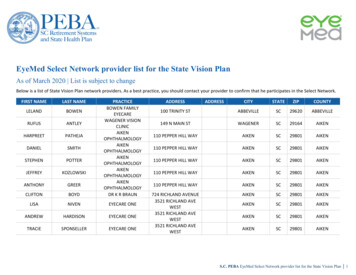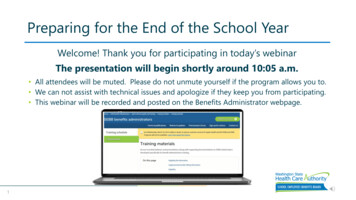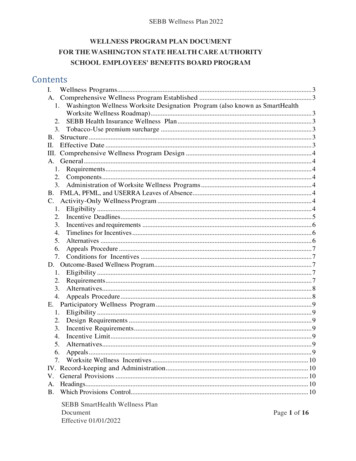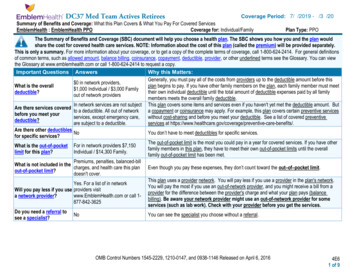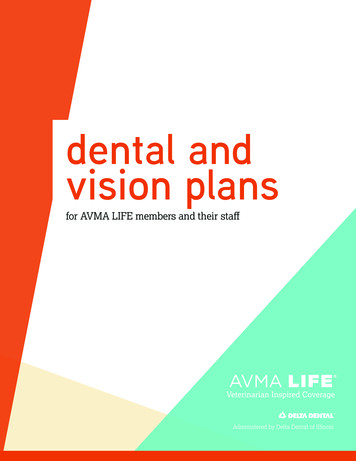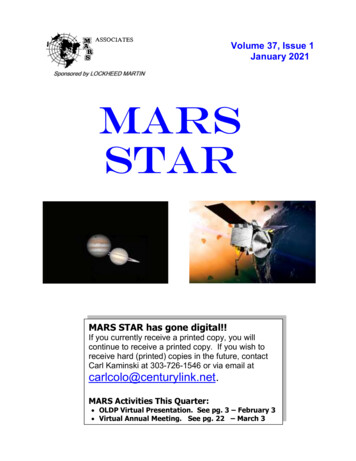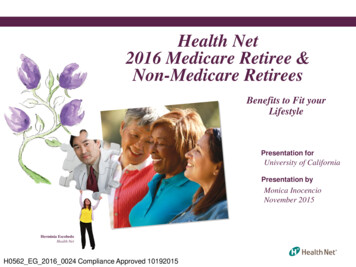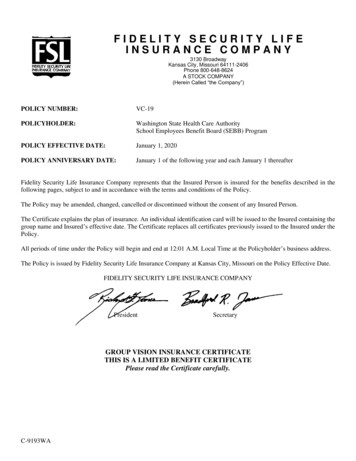
Transcription
FIDELITY SECURITY LIFEINSURANCE COMPANY3130 BroadwayKansas City, Missouri 64111-2406Phone 800-648-8624A STOCK COMPANY(Herein Called “the Company”)POLICY NUMBER:VC-19POLICYHOLDER:Washington State Health Care AuthoritySchool Employees Benefit Board (SEBB) ProgramPOLICY EFFECTIVE DATE:January 1, 2020POLICY ANNIVERSARY DATE:January 1 of the following year and each January 1 thereafterFidelity Security Life Insurance Company represents that the Insured Person is insured for the benefits described in thefollowing pages, subject to and in accordance with the terms and conditions of the Policy.The Policy may be amended, changed, cancelled or discontinued without the consent of any Insured Person.The Certificate explains the plan of insurance. An individual identification card will be issued to the Insured containing thegroup name and Insured’s effective date. The Certificate replaces all certificates previously issued to the Insured under thePolicy.All periods of time under the Policy will begin and end at 12:01 A.M. Local Time at the Policyholder’s business address.The Policy is issued by Fidelity Security Life Insurance Company at Kansas City, Missouri on the Policy Effective Date.FIDELITY SECURITY LIFE INSURANCE COMPANYPresidentSecretaryGROUP VISION INSURANCE CERTIFICATETHIS IS A LIMITED BENEFIT CERTIFICATEPlease read the Certificate carefully.C-9193WA
TABLE OF CONTENTSSCHEDULE OF BENEFITS . 1ADEFINITIONS . 3ELIGIBILITY AND ENROLLMENT . 4BENEFITS . 12LIMITATIONS . 12EXCLUSIONS . 12TERMINATION OF INSURANCE . 13PREMIUMS . 13CLAIMS . 13GENERAL PROVISIONS . 14C-9193WA2
DEFINITIONSAllowance means the benefit amount shown in the Schedule of Benefits that is the maximum amount payable by theCompany, subject to the expenses incurred. The Insured Person is responsible for any amounts due above the Allowance.The Allowance cannot be used to satisfy a Copayment.Benefit Frequency means the period of time in which a benefit is payable as shown in the Schedule of Benefits.The Benefit Frequency begins on January 1. Each new Benefit Frequency begins at the expiration of the previous BenefitFrequency, which is December 31 of the same year.Copayment or Copay means the designated amount, if any, shown in the Schedule of Benefits each Insured Person mustpay to a Provider before benefits are payable for a covered Vision Examination or Vision Materials per Benefit Frequency.Comprehensive Eye Examination means a general evaluation of the complete visual system. The examination includeshistory, general medical observation, external and ophthalmoscopic examinations, gross visual fields, basic sensorimotorexamination and Refraction. It always includes initiation of diagnostic and treatment programs. It may includebiomicroscopy, examination with cycloplegia or mydriasis and tonometry, as determined by the Provider. These servicesmay be performed at different sessions but comprise only one Comprehensive Eye Examination.Dependent means a spouse, state-registered domestic partner or child of the Insured who meets the eligibility requirementsas shown in the Eligibility and Enrollment section, and whose coverage under the Policy is in force and has not ended.Formulary means a list, provided by the Company, of Vision Materials by tier, that are covered under the Policy as shownin the Schedule of Benefits.Insured means an employee of a K12 school district, educational service district or charter school within Washington, asdefined in RCW 41.05.011(6)(b), who meets the eligibility requirements as shown in the Eligibility and Enrollment section,and whose coverage under the Policy is in force and has not ended.Insured Person means the Insured. Insured Person will also include the Insured’s Dependents, if enrolled.In-Network Provider means a Provider who has signed a Preferred Provider Agreement with the Preferred ProviderOrganization (PPO).Medically Necessary Contact Lenses means that adequate functional vision correction cannot be achieved with spectaclesbut can be achieved with contact lenses. Conditions that qualify for Medically Necessary Contact Lenses are:1.2.3.4.Anisometropia of 3D in meridian powers;High Ametropia exceeding -12D or 12D in meridian powers;Keratoconus when vision is not correctable to 20/25 in either eye or both eyes using standard spectacle lenses; orvision impairments, other than Keratoconus, when vision can be improved by two lines on the visual acuity chart whencompared to best corrected standard spectacle lenses.Out-of-Network Provider means a Provider, located within the PPO Service Area, but is not an In-Network Provider.Policy means the Policy issued to the Policyholder providing “vision coverage.”Policyholder means the group named as the Policyholder in the face page of the Policy.PPO Service Area means the geographical area where the PPO is located. The PPO Service Area includes all counties inthe state of Washington. In addition, the PPO Service Area is national and includes In-Network Providers in all 50 statesand the District of Columbia.C-9193WA3
Preferred Provider Agreement means the agreement between the PPO and a Provider who agrees to become an InNetwork Provider. The Preferred Provider Agreement contains the rates and reimbursement methods for services andsupplies furnished by an In-Network Provider.Preferred Provider Organization (“PPO”) means a network of Providers and retail chain stores within the PPO ServiceArea that have signed a Preferred Provider Agreement.Premium Surcharge means a payment required by the Policyholder from a subscriber, in addition to the subscriber’smedical premium contribution, due to an enrollee’s tobacco use or an enrolled subscriber’s spouse or state registeredDomestic Partner choosing not to enroll in their employer-based group medical when:1. the spouse’s or state registered Domestic Partner’s share of the medical premium is less than ninety-five percent of theadditional cost an employee would be required to pay to enroll a spouse or state registered Domestic Partner in thePublic Employees Benefits Board (PEBB) Uniform Medical Plan (UMP) Classic; and2. the benefits have an actuarial value of at least ninety-five percent of the actuarial value of PEBB UMP Classic benefits.Provider means a person licensed by the state in which he or she is a resident to practice the healing arts or optometristwho is operating within the scope of his or her license for the service or treatment given. Provider also includes a dispensingoptician.Refraction means a test performed by a Provider to determine the glasses or contact lens prescription due to a refractiveerror (for example, nearsightedness, farsightedness, astigmatism or presbyopia).SEBB Organization means a K12 school district, educational service district or charter school within Washington.Vision Examination means any eye or visual examination shown in the Schedule of Benefits.Vision Materials means those materials provided for visual health and welfare shown in the Schedule of Benefits.ELIGIBILITY AND ENROLLMENTIn these sections, we may refer to an Insured as “school employees,” “subscribers” or “enrollees.” Additionally, “healthplan” is used to refer to a plan offering medical, vision, or dental coverage, or a combination developed by the SchoolEmployees Benefits Board (SEBB) and provided by a contracted vendor or self-insured plans administered by the HealthCare Authority (HCA).EligibilityThe school employee’s SEBB Organization will inform the school employee whether or not they are eligible for benefitsupon employment and whenever their eligibility status changes. The communication will include information about theschool employee’s right to appeal eligibility and enrollment decisions. Information about a school employee’s right to anappeal can be found on page 11 of this certificate of coverage. For information on how to enroll see the “Enrollment”section.To enroll an eligible dependent the subscriber must follow the procedural requirements described in the “Enrollment”section. The SEBB Program or SEBB Organization verifies the eligibility of all dependents and requires the subscriber toprovide documents that prove a dependent’s eligibility.C-9193WA4
The following are eligible as dependents:1. Legal spouse.2. State-registered domestic partner.3. Children. Children are eligible through the last day of the month in which their 26th birthday occurs except as describedin subsection (g) of this section. Children are defined as the subscriber’s:a. Children as defined in state statutes that establish a parent-child relationship, except when parental rights have beenterminated;b. Children of the subscriber’s spouse, based on the spouse’s establishment of a parent-child relationship, except whenparental rights have been terminated. The stepchild’s relationship to a subscriber (and eligibility as a dependent)ends on the same date the marriage with the spouse ends through divorce, annulment, dissolution, termination, ordeath;c. Children for whom the subscriber has assumed a legal obligation for total or partial support in anticipation ofadoption of the child;d. Children of the subscriber’s state-registered domestic partner, based on the state-registered domestic partner’sestablishment of a parent-child relationship, except when parental rights have been terminated. The child’srelationship to the subscriber (and eligibility as a dependent) ends on the same date the subscriber’s legalrelationship with the state-registered domestic partner ends through divorce, annulment, dissolution, termination,or death;e. Children specified in a court order or divorce decree for whom the subscriber has a legal obligation to providesupport or health care coverage;f. Extended dependent in the legal custody or legal guardianship of the subscriber, the subscriber’s spouse, orsubscriber’s state-registered domestic partner. The legal responsibility is demonstrated by a valid court order andthe child’s official residence with the custodian or guardian. Extended dependent child does not include a fosterchild unless the subscriber, the subscriber’s spouse, or the subscriber’s state-registered domestic partner hasassumed a legal obligation for total or partial support in anticipation of adoption; andg. Children of any age with a developmental or physical disability that renders the child incapable of self-sustainingemployment and chiefly dependent upon the subscriber for support and maintenance provided such condition occursbefore the age of 26. The following requirements apply to dependents with a disability: The subscriber must provide proof of the disability and dependency within 60 days of the child’s attainment ofage 26; The subscriber must agree to notify the SEBB Program in writing no later than 60 days after the date that thechild is no longer eligible under this subsection; A child with a developmental or physical disability who becomes self-supporting is not eligible under thissubsection as of the last day of the month in which they become capable of self- support; A child with a developmental or physical disability age 26 and older who becomes capable of self-support doesnot regain eligibility under this subsection if they later become incapable of self-support; and The SEBB Program (with input from the medical plan if enrolled in medical) will periodically verify theeligibility of a dependent child with a disability, but no more frequently than annually after the two-year periodfollowing the child’s 26th birthday, which may require renewed proof from the subscriber.EnrollmentA subscriber or subscriber’s dependent is eligible to enroll in only one SEBB vision plan even if eligibility criteria is metunder two or more subscribers. For example, a dependent child who is eligible for enrollment under two parents workingfor the same or different SEBB Organizations may be enrolled as a dependent under one parent, but not more than one.A school employee is required to enroll in a vision plan under their SEBB Organization. A school employee must submit aSchool Employee Enrollment/Change form to their SEBB Organization when they become newly eligible for SEBBbenefits. The form must be received no later than 31 days after the date the school employee becomes eligible. If the schoolemployee does not return the School Employee Enrollment/Change form by the deadline, the school employee will beenrolled in Metropolitan Life Vision Plan and any eligible dependents cannot be enrolled until the SEBB Program’s nextannual open enrollment or when an event occurs that creates a special open enrollment.C-9193WA5
How to enrollA school employee must submit a School Employee Enrollment/Change form to their SEBB Organization when theybecome newly eligible for SEBB benefits.To enroll an eligible dependent, the school employee must include the dependent’s information on the form and provide therequired document(s) as proof of the dependent’s eligibility. A dependent must be enrolled in the same health plan coverageas the subscriber. The dependent will not be enrolled if their eligibility is not verified.A subscriber or their dependents may also enroll during the SEBB Program’s annual open enrollment (see “Annual openenrollment” on page 6) or during a special open enrollment (see “Special open enrollment” beginning on page 7). Thesubscriber must provide proof of the event that created the special open enrollment.A school employee must notify their SEBB Organization to remove dependents within 60 days from the last day of themonth when the dependent no longer meets the eligibility criteria described under “Eligible Dependents” on page 4. Allother subscribers must notify the SEBB Program to remove a dependent within 60 days from the last day of the month whenthe dependent no longer meets the eligibility criteria described under “Eligible dependents” on page 4. Consequences fornot submitting notice within 60 days may include, but are not limited to: The dependent losing eligibility to continue vision plan coverage under one of the continuation coverage optionsdescribed on page 9 of this certificate of coverage; The subscriber being billed for claims paid by the vision plan that were received after the dependent lost eligibility; The subscriber being unable to recover subscriber-paid insurance premiums for a dependent that lost their eligibility;and The subscriber being responsible for premiums paid by the state for the dependent’s vision plan coverage after thedependent lost eligibility.When vision coverage beginsFor a school employee and their eligible dependents enrolling during the first annual open enrollment, vision coveragebegins on January 1, 2020.For a school employee and their eligible dependents enrolling when the school employee is newly eligible, vision coveragebegins the first day of the month following the date the school employee becomes eligible. The school employee’s benefitswill begin on the first day of work when their first day of work is on or after September 1, but not later than the first day ofschool for the current school year as established by the SEBB Organization.Exception: For a subscriber or their eligible dependents enrolling during a special open enrollment, vision coverage beginsthe first day of the month following the later of the event date or the date the online enrollment or required form is received.Exceptions:1. If the special enrollment is due to birth or adoption of a child, or when the subscriber has assumed a legal obligation fortotal or partial support in anticipation of adoption of a child, vision coverage begins as follows: For an employee, vision coverage will begin the first day of the month in which the event occurs; For the newly born child, vision coverage begins the date of birth; For a newly adopted child, vision coverage begins on the date of placement or the date a legal obligation is assumedin anticipation of adoption, whichever is earlier; or For a spouse or state-registered domestic partner of a subscriber, vision coverage will begin the first day of themonth in which the event occurs.2. For a spouse or state-registered domestic partner of a subscriber, vision coverage begins the first day of the month inwhich the event occurs.3. Enrollment of an extended dependent or a dependent with a disability will be the first day of the month following thelater of the event date or eligibility certification.C-9193WA6
Annual Open EnrollmentSchool employees may make the following changes to their enrollment during the SEBB Program’s annual open enrollment: Enroll or remove eligible dependents; orChange their vision plan.Other Subscribers may make the following changes to their enrollment during the SEBB Program’s annual open enrollment: Enroll in or terminate enrollment in a vision plan;Enroll or remove eligible dependents; orChange their vision plan.The school employee must submit the change online or return the required enrollment/change form to their SEBBOrganization. All other subscribers must submit the form to the SEBB Program. The form must be received no later thanthe last day of the annual open enrollment. The enrollment change will become effective January 1st of the following year.Special open enrollmentA subscriber may change their enrollment outside of the annual open enrollment if a special open enrollment event occurs.However, the change in enrollment must be allowable under Internal Revenue Code (IRC) and Treasury Regulations, andcorrespond to and be consistent with the event that creates the special open enrollment for the subscriber, the subscriber’sdependent, or both. The special open enrollment may allow a subscriber to: Change their vision plan; orEnroll or remove eligible dependents.To make an enrollment change, the school employee must make the change online in SEBB My Account or submit therequired form(s) to their SEBB Organization. All other subscribers must submit the form(s) to the SEBB Program.Subscribers self-paying for continuation coverage must submit their form(s) to the SEBB Program. The form(s) must bereceived no later than 60 days after the event that created the special open enrollment. In addition to the required forms, theSEBB Program or SEBB Organization will require the subscriber to provide proof of the dependent’s eligibility, proof ofthe event that created the special open enrollment, or both.Exception: If a school employee wants to enroll a newborn or child whom the school employee has adopted or has assumeda legal obligation for total or partial support in anticipation of adoption, the school employee should notify their SEBBorganization by submitting an enrollment form as soon as possible to ensure timely payment of claims. If adding the childincreases the premium, the required enrollment/change form must be received no later than sixty days after the date of thebirth, adoption, or the date the legal obligation is assumed for total or partial support in anticipation of adoption. Schoolemployees should contact their personnel, payroll, or benefits office for the required forms.See “Adding a New Dependent to Your Coverage” on page 5.When can a subscriber change their health plan?Any one of the following events may create a special open enrollment:1. Subscriber gains a new dependent due to:a. Marriage or registering a state-domestic partnership;b. Birth, adoption or when the subscriber assumes a legal obligation for total or partial support in anticipation ofadoption; orc. A child becomes eligible as an extended dependent through legal custody or legal guardianship.2. Subscriber or their dependent loses other coverage under a group health plan or through health insurance coverage, asdefined by the Health Insurance Portability and Accountability Act (HIPAA);3. Subscriber has a change in employment status that affects their eligibility for the employer contribution toward theiremployer-based group health plan;C-9193WA7
4. Subscriber has a change in employment from a SEBB organization to a public school that straddles county lines or isin a county that borders Idaho or Oregon, which results in the subscriber having different medical plans available. Thesubscriber may change their election if the change in employment causes:a. The subscriber’s current medical plan to no longer be available, in this case the subscriber may select from anyavailable medical plan; orb. The subscriber has one or more new medical plans available, in this case the subscriber may select to enroll in anewly available plan.c. As used in this subsection the term “public school” shall be interpreted to not include charter schools and educationalservice districts.5. Subscriber’s dependent has a change in their own employment status that affects their eligibility for the employercontribution under their employer-based group health plan;6. Subscriber or their dependent has a change in residence that affects health plan availability. If the subscriber moves andtheir current health plan is not available in the new location, the subscriber must select a new health plan otherwisethere will be limited network providers and covered services;7. A court order requires the subscriber or any other individual to provide insurance coverage for an eligible dependent ofthe subscriber (a former spouse or former state-registered domestic partner is not an eligible dependent);8. Subscriber or their dependent becomes entitled to coverage under Medicaid or a state Children’s Health InsuranceProgram (CHIP), or the subscriber or the subscriber’s dependent loses eligibility for coverage under Medicaid or CHIP;9. Subscriber or their dependent becomes eligible for state premium assistance subsidy for SEBB health plan coveragefrom Medicaid or a state CHIP;10. Subscriber or their dependent becomes entitled to coverage under Medicare, or the subscriber or a subscriber’sdependent loses eligibility for coverage under Medicare. If the subscriber’s current health plan becomes unavailabledue to the subscriber’s or a subscriber’s dependent’s entitlement to Medicare, the subscriber must select a new healthplan as described in WAC 182-30-085(1);11. Subscriber or their dependent’s current health plan becomes unavailable because the subscriber or enrolled dependentis no longer eligible for a health savings account (HSA); or12. Subscriber or their dependent experiences a disruption of care that could function as a reduction in benefits for thesubscriber or their dependent for a specific condition or ongoing course of treatment. The subscriber may not changetheir health plan election if the subscriber or a subscriber’s dependent physician stops participation with the subscriber’shealth plan unless the SEBB Program determines that a continuity of care issue exists. The SEBB Program will considerbut is not limited to considering the following:a. Active cancer treatment such as chemotherapy or radiation therapy;b. Treatment following a recent organ transplant;c. A scheduled surgery;d. Recent major surgery still within the postoperative period; ore. Treatment of a high-risk pregnancy.NOTE: If an enrollee’s provider or vision care facility discontinues participation with the vision plan, the enrollee may notchange vision plans until the SEBB Program’s next annual open enrollment or when another qualifying event occurs thatcreates a special open enrollment, unless the SEBB Program determines that a continuity of care issue exists. This plancannot guarantee that any one provider, facility, or other provider will be available or remain under contract with us.When may a subscriber enroll or remove eligible dependents?C-9193WA8
Any one of the following events may create a special open enrollment:1. Subscriber gains a new dependent due to:a. Marriage or registering a domestic partnership;b. Birth, adoption or when a subscriber has assumed a legal obligation for total or partial support in anticipation ofadoption; orc. A child becoming eligible as an extended dependent through legal custody or legal guardianship.2. Subscriber or a subscriber’s dependent loses other coverage under a group health plan or through health insurancecoverage, as defined by the Health Insurance Portability and Accountability Act (HIPAA);3. Subscriber has a change in employment status that affects the subscriber’s eligibility for the employer contributiontoward their employer-based group health plan;4. The subscriber’s dependent has a change in their own employment status that affects their eligibility for the employercontribution under their employer-based group health plan;5. Subscriber or a subscriber’s dependent has a change in enrollment under another employer- based group healthinsurance plan during its annual open enrollment that does not align with the SEBB Program’s annual open enrollment;6. Subscriber’s dependent has a change in residence from outside of the United States to within the United States, or fromwithin the United States to outside of the United States and that change in residence results in the dependent losing theirhealth insurance;7. A court order requires the subscriber, or any other individual to provide insurance coverage for an eligible dependentof the subscriber (a former spouse or former state-registered domestic partner is not an eligible dependent);8. Subscriber or their dependent becomes entitled to coverage under Medicaid or a state Children’s Health InsuranceProgram (CHIP) program, or the subscriber or a subscriber’s dependent loses eligibility for coverage under Medicaidor CHIP; or9. Subscriber or their dependent becomes eligible for a state premium assistance subsidy for SEBB health plan coveragefrom Medicaid or a state CHIP.When vision coverage endsVision coverage ends on the following dates:1. The SEBB Organization terminates the employment relationship. In this case, eligibility for the employer contributionends the last day of the month in which the employer-initiated termination notice is effective;2. The school employee terminates the employment relationship. In this case, eligibility for the employer contributionends the last day of the month in which the school employee’s resignation is effective; or3. The school employee’s work pattern is revised such that the school employee is no longer anticipated to work sixhundred thirty (630) hours during the school year. In this case, eligibility for the employer contribution ends as of thelast day of the month in which the change is effective.Premium payments and applicable premium surcharges become due the first of the month in which vision coverage iseffective. Premium payments and applicable premium surcharges are not prorated during any month, even if an enrolleedies or asks to terminate their vision before the end of the month.When vision plan enrollment ends, the enrollee may be eligible for continuation coverage under the Policy if they applywithin the timelines explained in the “Options for continuation of SEBB vision coverage” on page 9.If a subscriber enrolls in continuation coverage, the subscriber is responsible for timely payment of premiums and applicablepremium surcharges. If the monthly premium or applicable premium surcharge remains unpaid for 30 days, it will beconsidered delinquent. A subscriber is allowed a grace period of 30 days from the date the monthly premium or applicablepremium surcharge becomes delinquent to pay the unpaid premium balance or surcharge. If the subscriber’s premiumbalance or applicable premium surcharge remains unpaid for 60 days from the original due date, the subscriber’s visioncoverage (including enrolled dependents) will be terminated retroactive to the last day of the month for which the monthlypremium and any applicable premium surcharge was paid.A school employee who needs the required forms for an enrollment or benefit change may contact their SEBB Organization.All other subscribers may contact the SEBB Program at the 1-800-200-1004.C-9193WA9
Medicare entitlementIf a school employee or their dependent becomes entitled to Medicare, they should contact the nearest Social SecurityAdministration office to ask about the advantages of immediate or deferred Medicare enrollment.Options for continuation of SEBB vision coverageA school employee and their dependent covered by this vision plan has options for continuing insurance coverage duringtemporary or permanent loss of eligibility. There are two contin
2. High Ametropia exceeding -12D or 12D in meridian powers; 3. Keratoconus when vision is not correctable to 20/25 in either eye or both eyes using standard spectacle lenses; or 4. vision impairments, other than Keratoconus, when vision can be improved by two lines on the visual acuity chart when compared to best corrected standard spectacle .
